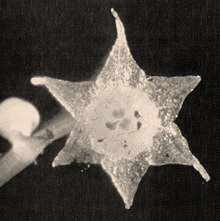Lacandonia schismatica is a species of mycoheterotrophic plant in the Triuridaceae (although some taxonomists place the genus in a separate family; the Lacandonaceae.). It is endemic to Lacandon Jungle in the State of Chiapas in southern Mexico.[1] It is known from very few populations and is considered endangered by the researchers who investigate this species.[2] It, and its recently discovered relation Lacandonia braziliana, are the only known flowering plants which in its natural population has a spatial inversion of the reproductive floral whorls (ie stamens and carpels): the 2 to 4 stamens are positioned centrally within the flower, and the 60 to 80 carpels arranged in a ring around them.[3] [4] Perhaps even more remarkable than the reversed positions of male and female parts is the unique mode of pollination. The pollen grain never leaves the anther, but sends the pollen tube backwards through the length of the stamen, across the receptacle and then into the pistil from below.[5]
| Lacandonia schismatica | |
|---|---|

| |
| Flower of Lacandonia schismatica | |
| Scientific classification | |
| Kingdom: | Plantae |
| Clade: | Tracheophytes |
| Clade: | Angiosperms |
| Clade: | Monocots |
| Order: | Pandanales |
| Family: | Triuridaceae |
| Genus: | Lacandonia |
| Species: | L. schismatica
|
| Binomial name | |
| Lacandonia schismatica E.Martínez & Ramos
| |
Lacandonia schismatica is known from several small populations at altitudes around 200 m (656 ft) in the Lacandon Jungle. It grows in shady sites within this rainforest. Gerrit Davidse and Esteban Martínez noted in 1990 how the plants are "extremely localized and highly endangered" due to encroaching habitat conversion to cattle pasture. They also explain that the species is difficult to cultivate and therefore they encourage other scientists to study this unique organism's biology before it can no longer be found in the wild.[6][7][8]
References
edit- ^ Kew World Checklist of Selected Plant Families
- ^ Davidse, G. & al. (eds.) (1994). Flora Mesoamericana 6: 1-543. Universidad Nacional Autónoma de México, México, D.F.
- ^ Vergara‐Silva, Francisco; Espinosa‐Matías, Silvia; Ambrose, Barbara A.; Vázquez‐Santana, Sonia; Martínez‐Mena, Alejandro; Márquez‐Guzmán, Judith; Martínez, Esteban; Meyerowitz, Elliot M.; Alvarez‐Buylla, Elena R. (2003). "Inside‐Out Flowers Characteristic of Lacandonia schismatica Evolved at Least before Its Divergence from a Closely Related Taxon, Triuris brevistylis". International Journal of Plant Sciences. 164 (3): 345–357. doi:10.1086/368235. ISSN 1058-5893.
- ^ Davidse, Gerrit; Martinez, Esteban (December 1990). "Chromosome Number of Lacandonia schizmatica (Lacandoniaceae)". Systematic Botany. 15 (4): 635.
- ^ Mestel, Rosie (January 1995). "Is that a Pistil in Your Pocket?". Discover. 16 (1): 88-89.
- ^ Márquez-Guzmán, J., Vázquez-Santana, S., Engleman, E. M., Martínez-Mena, A., and Martínez, E. (1993). Pollen development and fertilization in Lacandonia schismatica (Lacandoniaceae). Annals of the Missouri Botanical Garden, 80(4): 891-897.
- ^ Davidse, G. and Martínez, E. (1990). The chromosome number of Lacandonia schismatica (Lacandoniaceae). Systematic Botany, 15(4): 635-637.
- ^ Francisco Vergara-Silva, Silvia Espinosa-Matías, Barbara A. Ambrose, Sonia Vázquez-Santana, Alejandro Martínez-Mena, Judith Márquez-Guzmán, Esteban Martínez, Elliot M. Meyerowitz, and Elena R. Alvarez-Buylla. (2003). Inside-out flowers characteristic of Lacandonia schismatica evolved at least before its divergence from a closely related taxon, Triuris brevistylis. International Journal of Plant Sciences, 164(3): 345-357.